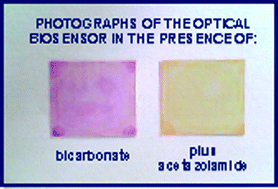Flow-through sol–gel optical biosensor for the colorimetric determination of acetazolamide
Abstract
An optical biosensor based on immobilised carbonic anhydrase and its application to the determination of the anti-glaucoma agent acetazolamide by enzyme inhibition measurements, is described. The enzyme and a pH indicator dye, cresol red, were physically immobilised in overlapped sol–gel thin films, in a dual-layer format. Carbonic anhydrase catalyses the dehydration of HCO3−, which in turn causes a change of pH in the microenvironment of the sensor. By following the colour transition of cresol red, the enzymatic reaction as well as its inhibition by acetazolamide can be monitored. The sensor was integrated in a flow cell and coupled to a continuous flow system operating on a multicommutation and binary sampling approach. Measurements were made at pH 6.0 at the wavelength of 570 nm. Linear response was obtained for acetazolamide concentrations between 1.0 and 10.0 mmol l−1, with a sampling frequency of 22 samples h−1 and a detection limit of 0.2 mmol l−1. The results obtained in the analysis of real samples were in good agreement with those obtained by a reference method, showing no significant differences at a confidence level of 95%.


 Please wait while we load your content...
Please wait while we load your content...